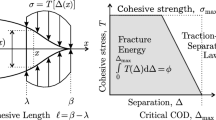Abstract
Recently, the authors (Xiao and Karihaloo, J Mech Mater Struct 1:881–910, 2006) obtained universal asymptotic expansions at a cohesive crack tip, analogous to the Williams (ASME J Appl Mech 24:109–114, 1957) expansions at a traction-free crack tip for any normal cohesion-separation law (i.e. softening law) that can be expressed in a special polynomial. This special form ensures that the radial and angular variations of the asymptotic fields are separable as in the Williams expansions. The coefficients of the expansions of course depend nonlinearly on the softening law and the boundary conditions. They demonstrated that many commonly-used cohesion-separation laws, e.g., rectangular, linear, bilinear and exponential, can indeed be expressed very accurately in this special form. They also obtained universal asymptotic expansions when the cohesive crack faces are subjected to Coulomb friction. The special polynomial involves fractional powers which seem rather contrived. In this paper, we will show that the asymptotic expansions can be obtained in a separable form even when the cohesion-separation law is in a special polynomial form involving only integer powers.
Similar content being viewed by others
References
Abdalla HM, Karihaloo BL (2004) A method for constructing the bilinear tension softening diagram of concrete corresponding to its true fracture energy. Mag Concrete Res 56: 597–604
Babuška I, Banerjee U, Osborn JE (2003) Survey of meshless and generalized finite element methods: A unified approach. Acta Numerica 12: 1–125
Barenblatt GI (1962) The mathematical theory of equilibrium cracks in brittle fracture. Adv Appl Mech 7: 55–129
Chandra N, Li H, Shet C, Ghonem H (2002) Some issues in the application of cohesive zone models for metal–ceramic interfaces. Int J Solids Struct 39: 2827–2855
Cocchetti G, Maier G, Shen XP (2002) Piecewise linear models for interfaces and mixed mode cohesive cracks. CMES-Comp Model Eng Sci 3: 279–298
Cornelissen HAW, Hordijk DA, Reinhardt HW (1986) Experimental determination of crack softening characteristics of normal and lightweight concrete. Heron 31: 45–56
Dugdale DS (1960) Yielding of steel sheets containing slits. J Mech Phys Solids 8: 100–108
Hillerborg A, Modéer M, Petersson PE (1976) Analysis of crack formation and crack growth in concrete by means of fracture mechanics and finite elements. Cement Concrete Res 6: 773–782
Hong SS, Kim KS (2003) Extraction of cohesive-zone laws from elastic far-fields of a cohesive crack tip: a field projection method. J Mech Phys Solids 51: 1267–1286
Hutchinson JW, Evans AG (2000) Mechanics of materials: top-down approaches to fracture. Acta Mater 48: 125–135
Karihaloo BL (1995) Fracture mechanics and structural concrete. Addison Wesley Longman, UK
Karihaloo BL (1999) Size effect in shallow and deep notched quasi-brittle structures. Int J Fract 95: 379–390
Karihaloo BL, Xiao QZ (2003a) In: Milne I, Ritchie RO, Karihaloo BL (eds) Linear and nonlinear fracture mechanics. In: Comprehensive structural integrity; Karihaloo BL, Knauss WG (eds) Volume 2: Fundamental theories and mechanisms of failure, Chap. 2.03. Elsevier Pergamon, UK, pp 81–212
Karihaloo BL, Xiao QZ (2003b) Modelling of stationary and growing cracks in FE framework without remeshing: a state-of-the-art review. Comput Struct 81: 119–129
Karihaloo BL, Abdalla HM, Imjai T (2003) A simple method for determining the true specific fracture energy of concrete. Mag Concrete Res 55: 471–481
Liu XY, Xiao QZ, Karihaloo BL (2004) XFEM for direct evaluation of mixed mode SIFs in homogeneous and bi-materials. Int J Numer Methods Eng 59: 1103–1118
Moës N, Dolbow J, Belytschko T (1999) A finite element method for crack growth without remeshing. Int J Numer Methods Eng 46: 131–150
Muskhelishvili NI (1953) Some basic problems of mathematical theory of elasticity. Noordhoff, Holland
Sih GC, Liebowitz H (1968) Mathematical theories of brittle fracture. In: Liebowitz H(eds) Fracture: an advanced treatise, vol II. Academic Press, New York, pp 67–190
Strouboulis T, Copps K, Babuška I (2001) The generalized finite element method. Comput Methods Appl Mech Eng 190: 4081–4193
Valente S (1991) Influence of friction on cohesive crack-propagation. In: Fracture Processes in Concrete, Rock and Ceramics, vol 2 (van Mier JGM, Rots JG, Bakker A (eds) RILEM proceedings 13). E & FN SPON, London, pp 695–704
Williams ML (1957) On the stress distribution at the base of a stationary crack. ASME J Appl Mech 24: 109–114
Xiao QZ, Karihaloo BL (2005) Recent developments of the extended/generalized FEM and a comparison with the FEM. In: Developments and applications of solid mechanics (Wu XP (eds) Proceedings of the symposium for professor M. G. Huang’s 90th birthday). Press of University of Science and Technology of China, China, pp 303–324
Xiao QZ, Karihaloo BL (2006) Asymptotic fields at frictionless and frictional cohesive crack tips in quasi-brittle materials. J Mech Mater Struct 1: 881–910
Xiao QZ, Karihaloo BL, Liu XY (2007) . Incremental–secant modulus iteration scheme and stress recovery for simulating cracking process in quasi-brittle materials using XFEM. Int J Numer Methods Eng 69: 2606–2635
Author information
Authors and Affiliations
Corresponding author
Rights and permissions
About this article
Cite this article
Karihaloo, B.L., Xiao, Q.Z. Asymptotic fields at the tip of a cohesive crack. Int J Fract 150, 55–74 (2008). https://doi.org/10.1007/s10704-008-9218-2
Received:
Accepted:
Published:
Issue Date:
DOI: https://doi.org/10.1007/s10704-008-9218-2




